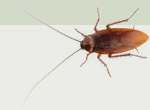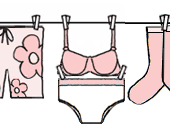
How to get rid of cockroaches, safely
Posted in Healthy Home on June 26, 2013 by FloridaHealth.com staff. Last modified on September 27, 2019. Read disclaimer.

While no place in America is off limits for bug infestations, Florida has it the worst -- that's according to a survey sponsored by BASF The Chemical Company. Ants... termites... germ-carrying, disease-spreading, allergy-triggering cockroaches -- Floridians have them all.
+ Free Shipping & Returns on Eligible Items.
If you think that only "dirty" homes have cockroaches, you're mistaken! Roaches are often carried home accidentally in grocery bags, boxes and other unsealed containers that have been stored in infested areas. And once they are inside a home or apartment, cockroaches can crawl easily through wall and ceiling voids to avoid being disturbed by efforts to control them -- such as spraying or painting. For these reasons, even the cleanest home or apartment cannot always escape these invading pests.
Cockroaches have three basic needs: food, water, and a warm dark place in which to live and breed. Take away their food and water and roaches will have a difficult time thriving in your home! It makes sense then that kitchens provide the most opportunities for roaches to satisfy these needs. Although there are obvious items and places that attract cockroaches in a house or apartment, they can find small amounts of food and water in places that we never even think about. In a sense, you must "think like a cockroach" and look for problems in these areas. You must think of your home in terms of "areas of activity", that is, different activities that you do that may somehow attract cockroaches. Examples of such activities include cooking and storing food, washing and storing dishes, cooking utensils, and clothes, and even bathing. The checklist (below) of roach activity areas will help you inspect your home for possible problems and suggest ways of correcting them.
 How to get rid of cockroaches in apartments
How to get rid of cockroaches in apartments
For most people, finding even a single roach is unpleasant, but in an apartment complex, a goal of finding no roaches is not always possible. Seeing only a few roaches may be the only results that can be achieved. Cockroach control takes time and a great deal of cooperation among residents, management, and the pest control professional to make all apartments less attractive and less open to cockroaches. If a pest control technician is servicing your apartment, make sure that you tell him or her (or the apartment manager) about areas where you have seen cockroaches. You can even make a drawing of your apartment and mark the areas where you find roaches or roach droppings.
Try to solve problems mentioned on the checklist. At the same time, try to avoid creating problems by making your own control attempts that might conflict with their control measures. For example, many people apply boric acid powder where they see roach activity even though the area has been treated with an insecticide. However, the powder is often applied as a heavy layer instead of a thin dusting (as explained on the product label). As a result, the cockroaches avoid both the boric acid and the insecticide-treated area -- making it less likely that the cockroaches will be killed by the pesticide (or the boric acid). Thus, the problem continues.
Plastic cockroach baits are useful, but they should not be placed in areas where children or pets can reach them. If you want to try roach control measures of your own, ask the pest control technician for advice. In the end, cockroach control can be achieved, but everybody must contribute to the solution and not be part of the problem.
Important things to remember are:
- Ideal conditions are humidity over 55% + 80° temperatures.
- Roaches need an opening no thicker than a quarter.
 What does cockroach poop look like? Small cockroach poop looks like specs of ground coffee or black pepper or even dark stains or smears. Droppings from larger roaches could easily be mistaken for mouse poop except that large roach droppings are slightly smaller and have ridges running lengthwise. You may not notice just a few but clusters are pretty easy to spot. Often, fecal smears are seen on doorways since door frames are popular hiding places. Other hotspots for roach feces are in, under and behind all kitchen appliances -- stove drawers, doors, fridge motor, side of fridge. Storage areas with cardboard boxes and papers are another favorite hiding spot.
What does cockroach poop look like? Small cockroach poop looks like specs of ground coffee or black pepper or even dark stains or smears. Droppings from larger roaches could easily be mistaken for mouse poop except that large roach droppings are slightly smaller and have ridges running lengthwise. You may not notice just a few but clusters are pretty easy to spot. Often, fecal smears are seen on doorways since door frames are popular hiding places. Other hotspots for roach feces are in, under and behind all kitchen appliances -- stove drawers, doors, fridge motor, side of fridge. Storage areas with cardboard boxes and papers are another favorite hiding spot.- 50-60% of asthmatics are sensitive to airborne roach saliva, feces and body parts that have been shed.
How bad is your cockroach infestation?
The following checklist will help you to 1) identify cockroach activity and the scope of an infestation and 2) offer solutions.
Kitchen
| Area | Potential Problems | Solution |
|---|---|---|
| Sink | Roaches attracted to unwashed dishes, cooking utensils, water left overnight in sink or on drain board, and food left in sink drain. | Do not leave unwashed dishes, cups, pots, pans, cooking and eating utensils overnight. Dry sink and drain board completely each night. Clean out stopper after using washing dishes. |
| Under Sink | Roaches attracted to water from moisture and/or leaks on and around water pipes, They may hide in holes around pipes or among clutter in cabinet. | Repair any leaks, plug holes in walls, clean, declutter and organize area under sink. |
| Countertops | Roaches attracted to spilled food and drinks or uncovered food items. | Cleanup spills, food particles and grease as soon as possible; clean and dry countertops every night. Never leave food out uncovered overnight. Seal gaps around countertop and backsplash behind sink. Clean and caulk gaps in cabinets and shelving. |
| Overhead or Panty Cabinets | Roaches attracted to spilled food (such as rice and cereals) and open packages. They may hide inside or behind the cabinets. | Keep open packages in sealable containers or in refrigerator. Clean up any spilled items. |
| Below-Counter Cabinets | Roaches attracted to pots and pans put away while still wet They may hide among stored grocery bags or inside and behind cabinet and drawers. | Dry pots and pans completely before putting them away. Discard, recycle or store bags outdoors. Clean under drawers. |
| Stove | Roaches attracted to grease, cooked and spilled food left on top of stove, or grease spattered on hood and wall | Clean stove top after cooking. Keep leftover food covered or refrigerated. Clean grease from hood walls, and areas around stove. |
| Refrigerator | Spilled food underneath. Roaches seen in area around motor and coils. | Clean under and behind refrigerator. Do not allow water to pool in drip pan under refrigerator. Fix deteriorated refrigerator door seals. |
| Dishwasher | Roaches attracted to moisture from standing water. Roaches may hide in motor area and in holes in wall around pipes. | Check for leaks around door seals, report any leaks to manager. |
| Other Appliances* | Roaches are attracted to spilled food and crumbs inside and underneath items; they may hide inside electrical component area. | Clean appliances after use; do not allow crumbs to accumulate. |
| Water Heater | Roaches attracted to moisture around or under water pipes. | Call plumber, if needed. Renters should report any leaks to the manager. Keep area as dry as possible. |
| Recycling and Garbage | Roaches attracted to cans and bottles containing water or food; they may hide among newspapers and grocery bags. | Clean bottles and cans thoroughly and allow them to dry before depositing in bins. Keep garbage, garden compost and recyclables in clean, tightly sealed containers or outside (if possible). Don't accumulate garbage or recyclable items for long periods. |
* Appliances include toasters, toaster ovens, microwave ovens, can openers, even radios and televisions.
Bathroom
| Area | Potential Problems | Solution |
|---|---|---|
| Sink | Roaches are attracted to water left overnight in sink. | Dry sink and countertop completely each night. Check drain overflow cavities and drains. |
| Under Sink | Roaches are attracted to water from moisture and/or leaks on and around water pipes. They may hide in holes around pipes or among clutter in cabinet. | Fix any leaks or openings in the wall, between tiles or fiberglass panels. Keep area organized and free of clutter. |
| Bathtub/Shower | Roaches are attracted to water in tub. They may hide in areas behind water faucets, shower heads, etc. | Report any leaks or openings in the wall to the manager. Keep area organized and free of clutter. |
| Linen Closet | Roaches hide in stored towels and bed linen. | Check closet thoroughly for roaches or roach feces. |
| Medicine Cabinets | Roaches hide inside or behind the cabinet. | Check closet thoroughly for roaches or roach feces. |
| Clothing Hampers | Roaches hide among damp and soiled clothing. | Avoid piling damp clothes in the hamper; if possible, let them dry first. |
Basement
| Area | Potential Problems | Solution |
|---|---|---|
| Foundation Floor and Walls. Floor Drains. | Roaches like cool moist conditions and can enter home through basement floor drains or cracks in foundation, floor or walls. | Address all possible sources of moisture and repair openings. Seal large cracks with steel wool. Cover floor drains with window screen |
| Carpeting | Oriental roaches love living beneath basement carpeting. | Replace carpeting with tile or paint basement floor |
| Laundry | Don't leave damp, dirty laundry lying around. If you accumulate laundry before washing it, allow dirty clothes to dry out in the meantime. | Report any leaks or openings in the wall to the manager. Keep area organized and free of clutter. |
| Water Pipes | Sweating pipes or leaky pipes that permit water to seep behind walls. | Insulate or repair pipes. |
| Sinks, Showers, Tub | Water that leaks behind or beneath sinks, tubs, etc. | Fix or seal gaps or worn grout around sinks, and tubs. |
Miscellaneous Indoor
| Area | Potential Problems | Solution |
|---|---|---|
| Houseplants | Water collects in drip tray. | Avoid over watering plants but, if you do, empty drip tray. |
| Pet food | Food bowls left out overnight. | Do not leave pet foods out overnight and store pet and human foods in tightly sealed containers. |
| Excess clutter | Clutter provides hiding places and potential food sources for roaches. | Get rid of any excess bags, boxes, magazines, newspapers, etc. Do not leave clothes lying on the floor. |
| Items brought into the house | Books, bags, groceries, items from yard sales, thrift shops, etc. | Inspect backpacks and food bags that kids bring home from school, library, etc. Also unpack groceries, thrift shop purchases, etc. (with a watchful eye) soon after arriving home and immediately discard any unnecessary boxes. |
Miscellaneous Outdoor
| Area | Potential Problems | Solution |
|---|---|---|
| Ground Cover | Excess or touching building. | Some species of cockroaches are more likely to make their way into the home from the outside. Trim back brush and rake away accumulated leaves and debris. Ground cover within 1 foot of house foundation should permit fast drying. (Outdoor cockroaches are attracted to pine mulch, fallen leaves, and in tree holes, including palm trees). Move stored firewood and garbage cans away from home. |
| Garbage cans | Too close to home. | Move garbage containers away from home with lids closed. |
| Screens on exterior doors and windows | Damaged, loose-fitting, or missing. | Make certain door and window screen fit snuggly. Seal gaps around window and doors with caulk or weather stripping. |
Cockroach Control Action Plan
1) Find where the roaches are living.
- Set out sticky traps -- even inexpensive glue board mouse traps will suffice.
- Look in all possible hiding places for dead roaches, egg cases and roach droppings.
- One by one, turn on lights in different rooms around the house and note where roaches run to.
2) Clean home thoroughly.
- As you find dead roaches or roach droppings, vacuum them up (using a vacuum with a HEPA filter) and clean the area thoroughly with hot soapy water or a 50/50 mix of vinegar and water since feces and scent trails left by roaches attract even more roaches. Discard vacuum bag into outdoor trash container.
3) Use pesticides including baits, growth regulators, sprays and dusts. Each of these pesticide forms has its advantages, depending on where in the home it is being used and the severity of an infestation. A good summary of each is available at http://edis.ifas.ufl.edu/ig082. (When using bait stations, discard them when empty. Otherwise, they will simply become additional places where roaches can hide.)
- Foggers, whether handled by a professional or do-it-yourself products are dangerous and an outdated approach. Roach foggers kill only what's out in the room, not what is hiding.
- Bait granules, stations, and gels are highly effective and relatively safe because of their targeted application.
 For a safer, natural roach killer, try Boric Acid (a stronger version of the household cleaner known as borax). This commonly available mineral powder is relatively safe for humans and pets but can be as deadly as insecticides to cockroaches when applied as directed.
For a safer, natural roach killer, try Boric Acid (a stronger version of the household cleaner known as borax). This commonly available mineral powder is relatively safe for humans and pets but can be as deadly as insecticides to cockroaches when applied as directed.
NOTE: Pesticides are poisonous so follow their directions and prevent children and pets from making contact.
Primary Source for this post:
Cockroach Control in Apartments, Michael Waldvogel, Extension Entomogist, NC State University
General bug pest eradication info tips from PSA Healthcare

 Germiest items in your home | Quiz
Germiest items in your home | Quiz When to wash clothes | Infographic
When to wash clothes | Infographic How to select, ripen and enjoy healthy avocados
How to select, ripen and enjoy healthy avocados Potty training tips for girls and boys
Potty training tips for girls and boys Home & yard mosquito control | Infographic
Home & yard mosquito control | Infographic 9 Beauty secrets to younger-looking skin
9 Beauty secrets to younger-looking skin Dietary needs of adults and older adults
Dietary needs of adults and older adults Can cranberry juice prevent urinary tract infections?
Can cranberry juice prevent urinary tract infections? 9 Foods that are delicious and super nutritious
9 Foods that are delicious and super nutritious What works (and what doesn't) for hangovers
What works (and what doesn't) for hangovers Tips for preventing or treating sunburns
Tips for preventing or treating sunburns Foods that are high in calcium for healthy bones
Foods that are high in calcium for healthy bones Action plan for getting rid of cockroaches
Action plan for getting rid of cockroaches What causes body odor and how to prevent it
What causes body odor and how to prevent it Important tips for preventing heart disease
Important tips for preventing heart disease Ha! Try this funny technique for managing stress
Ha! Try this funny technique for managing stress How to prevent and remove mold and mildew
How to prevent and remove mold and mildew Container gardening ideas
Container gardening ideas What is cholesterol and tips for managing it
What is cholesterol and tips for managing it